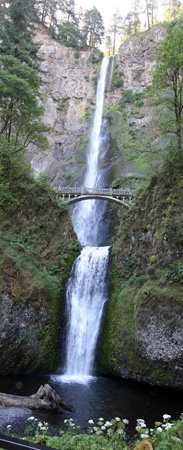Wabash men describe the great northwest as a land for dreamers, an area of incredible beauty, and place for progressive minds.
 I found all of that to be true. Over a two-week period I drove Interstate 5 from Portland, Oregon to Vancouver, British Columbia, Canada. The incredible mountain ranges frame the coast against the sea. The beautiful 300-mile drive is crowned by the majesty of the snow topped peaks of Mt. Hood, Mt. St. Helen, and Mt. Rainer.
I found all of that to be true. Over a two-week period I drove Interstate 5 from Portland, Oregon to Vancouver, British Columbia, Canada. The incredible mountain ranges frame the coast against the sea. The beautiful 300-mile drive is crowned by the majesty of the snow topped peaks of Mt. Hood, Mt. St. Helen, and Mt. Rainer.
The day I few home from Portland, I could see all three of the great mountains in alignment out the window as my plane ascended. It might have been the most breath-taking moment of the trip.
I drove up and over the famed Willamette Valley outside of Portland. And yes, visited the wineries known for their incredible Pinot Noir. I relished the unique urban atmosphere in Portland and Seattle.
I asked all of the nine Wabash men I visited about living in the northwest. I remember one morning in Seattle in particular. Andrew Naugle ‘98 was sitting at his desk on the 38th floor of the downtown Ranier Building. His descriptive thoughts about the Northwest are in the Magazine.
The one thing each of the men mentioned was the Northwest’s famous rainfall. It rains for most of the calendar year.
But there are weather advantages too. "It almost never snows," said Lee Grogg ’68, who spent most of his career in northwest Indiana. "I just love the fact that I almost never have to scrape the window."
And the mountains are inescapable.
"I enjoy the mountains," said Dr. David Avery ’68. "I have to say I don't mind not putting on chains for snow like I did in n Indiana. Snow is on the ground in Seattle a week out of the year maybe. It is cloudy and rainy, but it's 40 degrees out in the winter. It's actually good running weather. When it's rainy I put on a baseball cap and go out for a run. In the summers it's pretty dry. It doesn't get hot, doesn't get humid."
But there are differences anyone would understand in just a two-week visit.
"The culture is very outdoor minded and environmental," said Dan Schenk ’95, who works in Portland suburb Beaverton for Nike. "When I first moved out here, we drove through the Columbia gorge, the dams were there, and it was amazing that the city of Portland is powered by the dam. There is a negative side to that - it kills the salmon. People here are very active in running, biking, just being outside."
 You notice the bikers, walkers, and runners more in the northwest, at least I did. Approaching the sprawling Nike complex I saw bikers, runners, and skateboarders everywhere.
You notice the bikers, walkers, and runners more in the northwest, at least I did. Approaching the sprawling Nike complex I saw bikers, runners, and skateboarders everywhere.
But Schenk observes a little different mind-set than the Midwest as well. "To have grown up in the Midwest, it makes you feel like you earn a bit more of what you get," he said. "Coming here, it's a little more optimistic, there are more dreamers, more reaching for the stars mentality."
It’s many of those things the graduates describe that have people flocking to the northwest.
"I really feel it has to deal with lifestyle decisions and politics," said artist Nate Clark ’03. "There are a lot of artists and musicians here. I moved here for the music and the art. There are some really progressive bands out here based out of Portland. It’s also a very progressive area. We have lot of bikers. The city goes to great length to really promote public transportation; most cities are decreasing their public transportation while Portland is expanding it."
The northwest has a different feel than other cities. Portland and Seattle are often thought of together, but they’re very different places. Portland is a little edgier while Seattle has a more metropolitan feel.
Perhaps it is the mountains, or the stimulating sunny and cool 70 degree days. But even a short time in the area has an almost hypnotic effect. You find yourself thinking what a great place to live and maybe even a few ‘what ifs."
It’s easy to see why these Wabash men, eight of nine grew up in Indiana, now live and thrive in the Great Northwest.